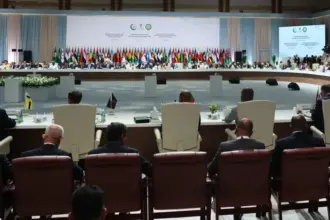An old man sits on the floor of an uncomfortable apartment in Beirut. But this is not his home. In 1948 he was exiled from Palestine and has been living in Lebanon ever since. The place he once called home is now a school for Israeli children.
British photographer Alan Gignoux brought many sad stories like these to Cairo through his exhibition Homeland Lost. He tells each story through two pictures: the first is that of Palestinian refugees today living somewhere in the Middle East; while the second is a picture of the land that once belonged to them.
The exhibition does not focus on refugee camps, however.
“We wanted to show that being a refugee does not necessarily mean living in camps. We wanted to show that there are middle class workers and upper class Palestinians living and working in the Arab world. that are sure as hell not going to live in Israel, says Gignoux. The characters he portrays belong to different classes, ages and religions and live in Jordan, Lebanon, The West Bank and Gaza, or are caught in the center of the Israeli state in “special camps.
Gignoux focuses on individuals who are trying to build a new life for themselves. But their stories will make you shudder with pity.
“Each of them has a heartbreaking story. they can’t ever go home, he says.
What used to be a thriving village amid lush agricultural land has become ruins.
Cairo was not Homeland Lost’s first stop. The reaction to the exhibit’s opening in Jerusalem was overwhelming, says Gignoux He couldn’t even enter the gallery because of the crowd.
He explains that the hall was full people belonging to Israel’s middle class, whose curiosity about the political situation in the region was piqued by the war with Lebanon last summer. They wanted to understand the Arabs.
One particular story was especially intriguing he says: “The house of a gentleman in Lebanon was hit in the 80s. His wife survived miraculously but his seven children died. He then had seven more children. So the Israelis see this and think, ‘we’re doomed’.
Gignoux is a professional reportage and portrait photographer and journalist who has covered the Middle East, South Africa, Serbia and Kosovo. After working on many development projects for organizations such as Care and the World Bank, he is now focusing on understanding human experience in unfamiliar environments.
This project was supported by the British Council and A.M. Qattan Foundation. It will continue to tour the Middle East then move to London, Ireland and Spain.
Gignoux plans to publish these photos in a book to be released next year in the United Kingdom.
Contemporary Image Collective (CIC)20 Safeya Zaghloul St., off Kasr El Aini St. Cairo.(012) 115 870011 am – 6pm except Friday and SaturdayUntil March 25
Alexandria Contemporary Arts Forum (ACAF)10 Hussein Hassab Street, flat no 6, Azarita, Alexandria(03) 480 4145www.acafspace.orgMarch 29- April 15


